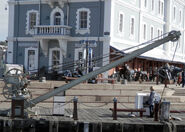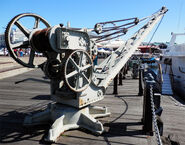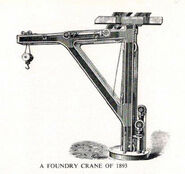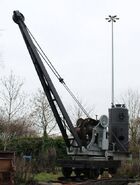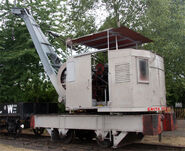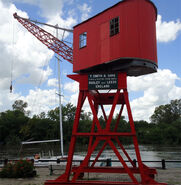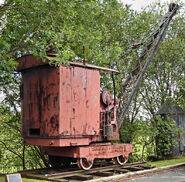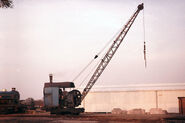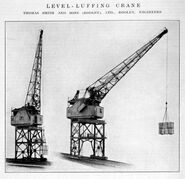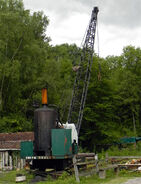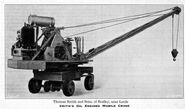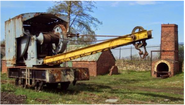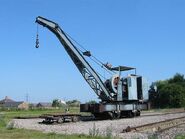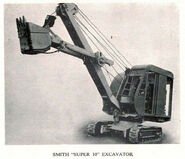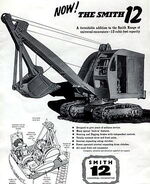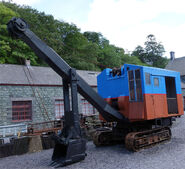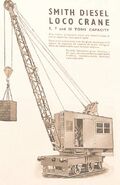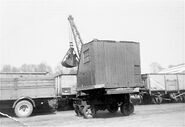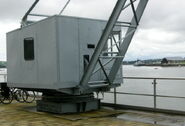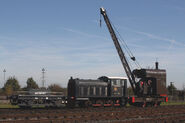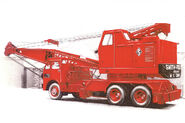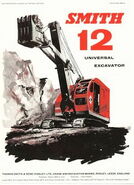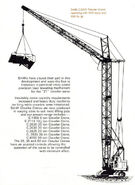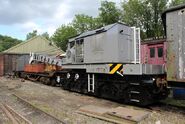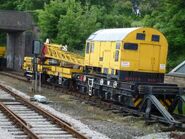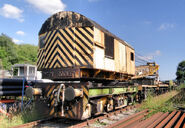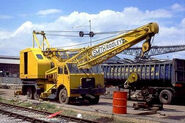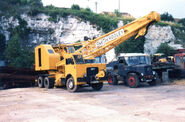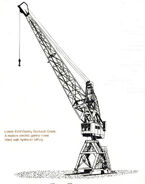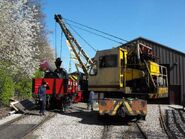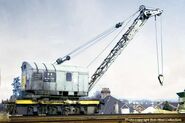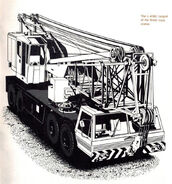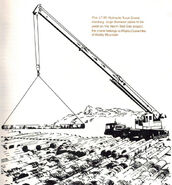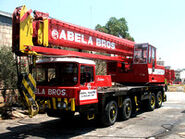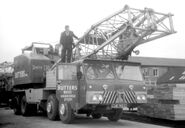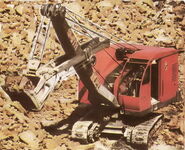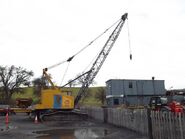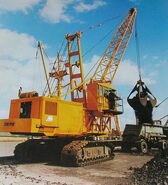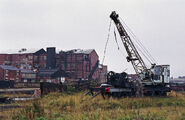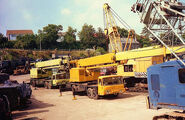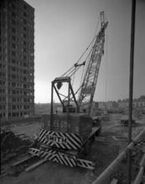BulldozerD11 (talk | contribs) (outline article) |
(Editing a gallery) |
||
| (28 intermediate revisions by 5 users not shown) | |||
| Line 1: | Line 1: | ||
| + | [[Image:Smith no 8 face shovel.JPG|thumb|250px|A Smith no.8 face shovel]] |
||
'''Thomas Smith & Sons (Rodley) Ltd''' was formed in 1918, The firm originating in the Village of Rodley, Leeds in Yorkshire. The Firm were a builder of [[Steam Cranes]] for Railways and Quaries, before going on to build [[Diesel engine]]d [[excavators]] and [[cranes]], and eventually Lorry mounted [[Latice jib]] cranes. |
'''Thomas Smith & Sons (Rodley) Ltd''' was formed in 1918, The firm originating in the Village of Rodley, Leeds in Yorkshire. The Firm were a builder of [[Steam Cranes]] for Railways and Quaries, before going on to build [[Diesel engine]]d [[excavators]] and [[cranes]], and eventually Lorry mounted [[Latice jib]] cranes. |
||
==History== |
==History== |
||
| + | {{expand}}[[File:Smith Rodley rail steam crane remains at NCMM - IMG 5268.jpg|thumb|Remains of a rail mounted Smith steam crane in the [[National Coal Mining Museum for England]] storage yard]] |
||
| ⚫ | The Company started in 1820 when a firm of millwrights was started by Jeremiah Balmforth,David Smith, and Jeremiah Booth in the village of Rodley. The company |
||
| + | [[File:Smith Rodley ME Crane on Atkinson chassis at Llandudno 09 - IMG 8600.jpg|thumb|A Smith Rodley T10 ME crane on a [[Atkinson]] chassis at the [[Llandudno Transport Festival]] 2009]] |
||
| ⚫ | The Company started in 1820 when a firm of millwrights was started by Jeremiah Balmforth, David Smith, and Jeremiah Booth in the village of Rodley. The company progressed to making Stone cutting machinery & winches. By 1840 most of the equipment being made was cranes. These being of various capacities from 1/2 ton to 10 ton, hand operated machines. They built there first steam crane in 1860. By 1861 David Smiths Son Thomas had taken control. The company was run as a partnership with his sons till he died in 1902, with the sons incorporating the company in 1918, as '''Thomas Smith & sons (Rodley) Ltd'''. |
||
===Early Developments=== |
===Early Developments=== |
||
| − | *1887 |
+ | *1887 Built their first ever excavator, of a steam crane fited with a shovel attachment. |
| − | *1894 |
+ | *1894 Built their first ever Electric crane. |
| − | *1887-1893 Contract to supply 5 & 10 ton |
+ | *1887-1893 Contract to supply 5 & 10 ton Steamcranes to Manchester ship canal builders called "Thomas A Walker" |
*1900 Build a trencher machine designed by Jubb from Manchester. Built on a 3 Ton Steam crane. |
*1900 Build a trencher machine designed by Jubb from Manchester. Built on a 3 Ton Steam crane. |
||
| + | * 1978 taken over by the [[NEI group]] who owned a number of related engineering and construction machinery businesses, before the 1980s recession forced the closure or disposal of a number of them. |
||
| + | The company built a several truck mounted cranes based on Cranecarriers from [[Atkinson]], [[AWD]].,Foden and Leyland. |
||
| − | * |
||
| ⚫ | |||
| ⚫ | |||
| ⚫ | |||
| + | * Smith 1/4 Yd. (1934) |
||
| + | * Smith Tree-Twelve. (1935) |
||
| + | * Smith Four-Fourteen. (1935) |
||
| + | * Smith Five-Twenty. (1935) |
||
| + | * Smith Two-ten (1935) |
||
| + | * Smith Seven |
||
| + | * Smith No.8 (eight) |
||
| + | * Smith No.10 (super-ten)(1946) |
||
| + | * Smith No.12 (19? |
||
| + | * Smith No.14 (1960) |
||
| + | * Smith No.21 (1946) |
||
| + | * Smith No.26 (1960) |
||
| + | * Smith no.28 (1970) |
||
| + | * Smith No.40 (1968) |
||
| + | ** Smith E4000 Excavator |
||
| + | ** Smith C4046 crane |
||
| + | ** Smith C4050 crane |
||
| + | ** Smith Eurocrane 25C |
||
| + | * Smith Eurocrane 35C |
||
| + | ==Preservation== |
||
| + | A few examples of Smiths cranes and excavators are in preservation including; |
||
| + | * A [[Smith No. 8]] (photo above) at the [[Vintage Excavator Trust]] museum in Cumbria. |
||
| ⚫ | |||
| + | * A [[Smith T10 ME]] of [[Buckley Crane Hire]] - [[Smith crane - VUG 175|VUG 175]] on [[Atkinson]] chassis.(photo above) |
||
| ⚫ | |||
| + | * A [[Smith 14]] crane parked at [[Andrew Beaulahs Open Day|Andrew Beaulahs]] yard. |
||
| ⚫ | |||
| + | * Smith steam crane sn 9087/1917 ? as WD2528 at the [[Berlin Tecnical Museum]] |
||
| + | * Smith steam crane sn 9511/1920 ? 10T Capacity on 4+4 Wheel bogies [[Mexico City Museum]] |
||
| + | * Please add any other examples in preservation to this list |
||
| + | {{PML Smith Rodley}}(link for future PML table) |
||
| + | Photo Gallery about '''THOMAS''' '''SMITH OF RODLEY''' Original Machinery Range |
||
| ⚫ | |||
| + | <gallery> |
||
| + | A 1880s Smith Of Rodley Road Steamcrane.jpg|A 1830s Smith Of Rodley Original Steam Railway Cranes |
||
| + | A 1900 Smith Of Rodley Railway Steamcrane preserved at a Steam Museum display near Carmathen Wales.jpg|A 1830s Smith Of Rodley Steam Railcrane now preserved at a Steam Museum display near Carmathen in Wales |
||
| + | A 1850s Smith Of Rodley 5T Steam Railcrane.jpg|A 1840s Thomas-Smith aka Smith Of Rodley Steam Railcrane 5T |
||
| + | A 1850s Smith Of Rodley Steamcrane at the Manchester Bolton & Bury Canal.jpg|A 1850s Smith Of Rodley Steamcrane at the Manchester Bury & Bolton Canal |
||
| + | A 1860 Smith Of Rodley Handcrane in Capetown.jpg|A 1860s Smith Of Rodlley 1T Handcrane in operation at Capetown, South Africa |
||
| + | A 1860 Smith Of Rodley Wharf Handcrane.jpg|A 1860s Smith Of Rodley 1T Manual Jetty Wharfcrane |
||
| + | A 1870 Smith Of Rodley Steam Railcrane Restored.jpg|A 1870s Smith Of Rodley Steam Railcrane restored working today in England |
||
| + | A 1870s Smith Of Rodley Steam Travelcrane.jpg|A 1870s Smith Of Rodley Steam Travel Railcrane 5T |
||
| + | A 1880s Smith Of Rodley Steam Crane Range.jpg|A 1880s Smith Of Rodley Original Steamcrane Model Range |
||
| + | A 1880s Smith Of Rodley Steam Railway Locomotive Crane.jpg|A 1880s Smith Of Rodley Steam Locomotive Railcrane |
||
| + | A 1880s Smith Of Rodley Steam Yardcrane.jpg|A 1890s Smith Of Rodley Steam Shunting Railcrane |
||
| + | A 1890 Smith Of Rodley Steam Shunting Crane.jpg|A 1890s Smith Of Rodley Steam Railway Shunting Crane |
||
| + | A 1890s Smith Of Rodley Foundry Crane.jpg|A 1890s Smith Of Rodley 5T Foundry Hoist Crane |
||
| + | A 1890s Smith Of Rodley Steam Overhead 15 T Crane.jpg|A 1890s Smith Of Rodley Industrial Overhead Steamcrane 15 T |
||
| + | A 1890s Smith Of Rodley Steam Railway 15T Crane.jpg|A 1890s Smith Of Rodley Industrial Steam Yardcrane 15T |
||
| + | A 1890s Smith Of Rodley Steam Railway Locomotive Crane.jpg|A 1890s Smith Of Rodley Steam Railway Yardcrane 15T |
||
| + | A 1900 Smith Of Rodley Steam Railcrane 5T.jpg|A 1900s Smith Of Rodley Steam Railway Locomotive Crane 15T |
||
| + | A 1900 Smith Of Rodley Steam Railcrane 20T awaiting restoration.png|A 1900s Smith Of Rodley 20T Steam Railway Crane awaiting restoration |
||
| + | A 1900 Smith Of Rodley Steam Railcrane in Uruguay.jpg|A 1900s Smith Of Rodley 10T Steam Railcrane preserved at Montevideo Uruguay |
||
| + | A 1900 Smith Of Rodley Steam Railcrane.jpg|A 1900s Smith Of Rodley 10T Steam Railcrane awaiting restoration |
||
| + | A 1910 Smith Of Rodley 3 Motor Electric Railcrane.jpg|A 1910s Smith Of Rodley Three Electric Motor Railcrane |
||
| + | A 1910 Smith Of Rodley Railway Shuntercrane.jpg|A 1910s Smith Of Rodley Railway Steam Shuntercrane 15T |
||
| + | A 1910 Smith Of Rodley Steam Railcrane.jpg|A restored 1910 Smith of Rodley Steam Railcrane 10T |
||
| + | A 1910 Smith Of Rodley Wharfcrane in Argentina.jpg|A restored 1910 Smith Of Rodley Quayside Crane in Argentina |
||
| + | A 1920s Smith Rodley Steam Crane at the Bradford Industrial Museum.jpg|A 1920s Smith Of Rodley Steampowered Railcrane at the Bradford Industrial Museum |
||
| + | A Smith Of Rodley Railway Steampowered Shuntercrane.jpg|A 1920s Smith Of Rodley Steampowered Railway Shuntercrane 15T |
||
| + | A 1920s Smith Of Rodley Steam Crane 10T.jpg|A 1920s Smith Of Rodley Electric Locomotive Railcrane |
||
| + | A 1920s Smith Of Rodley pair of Dockside Cranes.jpg|A 1920s Smith Of Rodley pair of Harbour Portside Cargocranes |
||
| + | A pair of 1930s Smith Of Rodley Railway Steamcranes.jpg|A pair of 1930s Smith Of Rodley Railway Steamcranes in Wales |
||
| + | A 1930s Smith Seven Dragline oil engined.png|A 1930s Smith Of Rodley Original Oil Engined Dragline |
||
| + | A 1930s Smith Of Rodley Steam Railcrane 10T.jpg|A 1930s Smith Of Rodley Railway Steamcrane 10T |
||
| + | A 1930s Smith Of Rodley Steam Railcrane awaiting restoration.jpg|A 1930s Smith Of Rodley Steampowered Railcrane awaiting restoration |
||
| + | A 1930s Smith Of Rodley Universal Excavator.jpg|A 1930s Smith Of Rodley Oil Engined Original Universal Excavator |
||
| + | A 1930s Smith Of Rodley Excavator working in a quarry.jpg|A 1930s Smith Of Rodley Original Excavator working in a quarry |
||
| + | A 1930s Smith Of Rodley Yardcrane oil engined.jpg|A 1930s Smith Of Rodley Oil Engined Original Yardcrane 10T |
||
| + | A 1920s Smith Of Rodley Crawler Excavator.jpg|A 1930s Smith Of Rodley Oil engined Crawler Excavator still working in a machinery yard |
||
| + | A 1940s Smith Of Rodley 8 Excavator.JPG|A 1940s Smith Of Rodley Petrol Engined Excavator Model 8 |
||
| + | A 1940s Smith Of Rodley Crawler Excavator.jpg|A 1940s Smith Of Rodley Petrol engined Crawler Excavator |
||
| + | A 1940s Smith Of Rodley Rail Steamcrane.png|A 1940s Smith Of Rodley Petrol engined Railcrane 10T |
||
| + | A 1940s Smith Of Rodley Railway Shuntercrane.jpg|A 1940s Smith Of Rodley Railway Shuntercrane 10T Diesel engined |
||
| + | A 1940s Smith Of Rodley Railway Shunting Crane Diesel 15 T.jpg|A 1940s Smith Of Rodley Shunting Railcrane 15T Diesel engined |
||
| + | A 1940s Smith Of Rodley Steam Railway Crane.jpg|A 1940s Smith Of Rodley Railway Shuntercrane 10T preserved in England |
||
| + | A 1940s Smith Of Rodley Steam Railcrane.jpg|A 1940s Smith Of Rodley Railway Shunting Crane restored in England |
||
| + | A 1940s Smith Of Rodley Universal Excavator oil engined.jpg|A 1940s Smith Of Rodley Universal Crawler Excavator Petrol engined model |
||
| + | A 1950s Smith Of Rodley Super10 Excavator Diesel.jpg|A 1950s Smith Of Rodley Super 10 Crawler Excavator Diesel |
||
| + | A 1950s Smith Of Rodley 12 Excavator Diesel.jpg|A 1950s Smith Of Rodley Crawler Excavator Model 12 Diesel |
||
| + | A 1950s Smith Of Rodley 14 Crawler Excavator Diesel.jpg|A 1950s Smith Of Rodley Crawler Excavator Model 14 Diesel |
||
| + | A 1950s Smith Of Rodley 21 Excavator Diesel.jpg|A 1950s Smith Of Rodley Crawler Excavator Model 21 Diesel |
||
| + | A 1950s Smith Of Rodley 14 Railcrane Diesel.JPG|A 1950s Smith Of Rodley Railway Locomotive Crane Diesel |
||
| + | A 1950s Smith Of Rodley Excavator Diesel.jpg|A 1950s Smith Of Rodley Universal Excavator Diesel |
||
| + | A 1950s Smith Of Rodley Wharfcrane Diesel.jpg|A 1950s Smith Of Rodley Pedestal Wharfcrane Diesel 10T |
||
| + | A 1950s Smith Of Rodley Steam Railcrane 5T.jpg|A 1950s Smith Of Rodley Railway Rolling Stock with Diesel Railcrane |
||
| + | A 1950s Smith Of Rodley LT20 Foden Cranetruck Diesel.jpg|A 1950s Smith Of Rodley Cantilever Mobilecrane 20T on Foden Cranecarrier Diesel |
||
| + | A 1960s Smith Of Rodley Railway Crane Diesel.jpg|A 1960s Smith Of Rodley Original Cranes Model Range |
||
| + | A 1960s Smith Of Rodley T20 Albiion Cranetruck.jpg|A 1960s Smith Of Rodley T20 Albion Cranetruck Diesel 8X4 |
||
| + | A 1960s Smith of Rodley Cranetruck on Atkinson carrier.jpg|A 1960s Smith Of Rodley MEI L30 Atkinson Cranetruck Diesel 8X4 |
||
| + | A 1960s Smith OF Rodley LT20 Leyland Cranetruck Diesel.jpg|A 1960s Smith Of Rodley MEI L30 Atkinson Cranetruck Diesel |
||
| + | A 1960s Smith Of Rodley T20 Cranetruck on Foden carrier.jpg|A 1960s Smith Of Rodley T20 Foden Cranetruck Diesel 6X4 |
||
| + | A 1960s Smith Cranetruck on Foden Carrier.jpg|A 1960s Smith Of Rodley T20 Foden Cranetruck 6X4 |
||
| + | A 1960s Smith Of Rodley Excavator on Foden truck.jpg|A 1960s Smith Of Rodley Excavator on Foden Cranecarrier |
||
| + | A 1960s Smith 15T Diesel Railcrane.jpg|A 1960s Smith Of Rodley Diesel Railway Shuntercrane 30T |
||
| + | A 1960s Smith Of Rodley 14 Crawlercrane Diesel.jpg|A 1960s Smith Of Rodley Universal Crawlercrane Diesel |
||
| + | A 1960s Smith Of Rodley 12 Excavator Diesel.jpg|A 1960s Smith Of Rodley Universal Crawler Excavator Model 12 Diesel |
||
| + | A 1960s Smith Of Rodley 21 Excavator Diesel.JPG|A 1960s Smith Of Rodley Crawler Excavator Model 21 Diesel |
||
| + | A 1960s Smith Of Rodley 40 Faceshovel Diesel.JPG|A 1960s Smith Of Rodley Faceshovel Diesel Model 40 |
||
| + | A 1960s Smith Of Rodley Crawlercrane Diesel.jpg|A 1960s Smith Of Rodley Construction Industrial Crawlercrane Diesel |
||
| + | A 1960s Smith Of Rodley Mobilecrane 5T Diesel.jpg|A 1960s Smith Of Rodley Industrial Yardcrane Diesel 15T |
||
| + | A 1960s Smith Of Rodley Railcrane Diesel 50T.jpg|A 1960s Smith Of Rodley Railway Diesel Shuntercrane 30T |
||
| + | A 1970s Smith Of Rodley Crane Catalogue.jpg|A 1970s Smith Of Rodley Original Diesel Cranes Model Range |
||
| + | A 1970s Smith Of Rodley C28 Crawler Excavator.jpg|A 1970s Smith Of Rodley Crawler Excavator C28 Diesel |
||
| + | A 1970s Smith C4046 Crawlercrane Diesel .jpg|A 1970s Smith Of Rodley Crawlercrane C4046 Diesel |
||
| + | A 1970s Smith Of Rodley 26 Dragline Diesel.jpg|A 1970s Smith Of Rodley Crawlercrane Diesel and FTF Haulage Tractor in Holland |
||
| + | A 1970s Smith Of Rodley 40 Excavator Diesel.jpg|A 1970s Smith Of Rodley Crawler Excavator Diesel Model 40 |
||
| + | A 1970s Smith Of Rodley 21 Excavator Diesel.jpg|A 1970s Smith Of Rodley Crawler Dragline Diesel Model 21 |
||
| + | A 1970s Smith Of Rodley 26 Excavator Diesel.JPG|A 1970s Smith Of Rodley Crawler Excavator Diesel Model 26 |
||
| + | A 1970s Smith Of Rodley 20T Railcrane Diesel.jpg|A 1970s Smith Of Rodley Raiway Shuntercrane Diesel 20T |
||
| + | A 1970s Smith Of Rodley 30T Railway Crane Diesel.jpg|A 1970s Smith Of Rodley Railway Shunter Locomotive Crane 30T |
||
| + | A 1970s Smith Cranetruck on Foden Diesel carrier.jpg|A 1970s Smith Of Rodley T20 Foden Cranetruck FC20 |
||
| + | A 1970s Smith Of Rodley Cranetruck on Foden carrier.jpg|Another 1970s Smith Of Rodley T20 Foden FC20 Cranetruck |
||
| + | A 1970s Smith Of Rodley Crawler Dragline Diesel.jpg|A 1970s Smith Of Rodley Crawler Dragline Diesel in a quarry |
||
| + | A 1970s Smith Of Rodley Faceshovel Diesel.jpg|A 1970s Smith Of Rodley Crawler Faceshovel Diesel used in mining |
||
| + | A 1970s Smith Of Rodley Dockside Crane Diesel.jpg|A 1970s Smith Of Rodley Dockside Cargocrane Diesel |
||
| + | A 1970s Smith Of Rodley Eurocrane 35 Crawlercrane Diesel.jpg|A 1970s Smith Of Rodley Eurocrane E35 Crawlercrane Diesel |
||
| + | A 1970s Smith Of Rodley Excavator E4000 Diesel.jpg|A 1970s Smith Of Rodley E4000 Crawler Excavator Diesel |
||
| + | A 1970s Smith Of Rodley Grabcrane Diesel.jpg|A 1970s Smith Of Rodley E4000 Grabcrane Diesel |
||
| + | A 1970s Smith Of Rodley Gantry Crane Diesel.jpg|A 1970s Smith Of Rodley Cargo Gantry Harbourcrane Diesel |
||
| + | A 1970s Smith Of Rodley Railway Dieel Electric Crane.jpg|A 1970s Smith Of Rodley 20T Diesel-Electric Railway Service Crane |
||
| + | A 1970s Smith Of Rodley Harbour Crane Diesel.jpg|A 1970s Smith Of Rodley Harbour Portside Cargocrane Diesel |
||
| + | A 1970s Smith Of Rodley Railway Crane Diesel 20T.jpg|A 1970s Smith Of Rodley Diesel Railway Shuntercrane 20T |
||
| + | A 1970s Smith Of Rodley Railcrane Diesel 15 T.jpg|A 1970s Smith Of Rodley Diesel Railway Yardcrane 15T |
||
| + | A 1970s Smith Of Rodley Shunting Railcrane 40 Diesel.jpg|A 1970s Smith Of Rodley Railway Diesel Servicecrane 30T |
||
| + | A 1970s Smith Of Rodley LT15 AWD Vickers cranetruck.jpg|A 1970s Smith Of Rodley LT15 AWD-Vickers IC Cranetruck 6X4 |
||
| + | A 1970s Smith Of Rodley T10 Albion Cranetruck.jpg|A 1970s Smith Of Rodley LT15 AWD-Vickers IC 6X6 Cranetruck Diesel |
||
| + | A 1970s Smith Of Rodley L4060 Cranetruck Diesel.jpg|A 1970s Smith Of Rodley L4060 Foden Cranetruck Diesel 8X4 |
||
| + | A 1970s Smith Of Rodley RTC 4X4 Mobilecrane Diesel.jpg|A 1970s Smith Of Rodley RTC 10T 4WD Telescopic Mobilecrane Diesel |
||
| + | A 1970s Smith Of Rodley LT30 Foden Cranetruck Diesel.jpg|A 1970s Smith Of Rodley LT30 Foden Cranetruck Diesel |
||
| + | A 1970s Smith Of Rodley LT30 on Foden Cranetruck.jpg|A 1970s Smith Of Rodley LT40 Foden Cranetruck Diesel 8X4 |
||
| + | A 1970s Smith Of Rodley LT30 Foden Cranetruck.jpg|A 1970s Smith Of Rodley LT40 Foden Cranetruck Diesel 8X4 |
||
| + | A 1970s Smith Of Rodley LT30 TD Foden Cranetruck.jpg|A 1970s Smith Of Rodley LT30 Foden Cranetruck in Scotland |
||
| + | A 1970s Smith Of Rodley LT18 Vickers AWD Cranetruck.jpg|A 1970s Smith Of Rodley LT18 Vickers-AWD Cranetruck 6X4 |
||
| + | A 1970s Smith Of Rodley LT30 Vickers AWD Cranetruck.jpg|A 1970s Smith Of Rodley LT30 Vickers-AWD Cranetruck in England |
||
| + | A 1970s Smith Of Rodley T30 Cranetruck on Foden carrier.jpg|A 1970s Smith Of Rodley LT40 Foden Cranetruck Diesel 8X4 |
||
| + | A 1970s Smith Of Rodley Super 10 Excavator Diesel.jpg|A 1980s Smith Of Rodley Super 10 Crawler Excavator Diesel |
||
| + | A 1980s Smith Of Rodley Super 12 Dragline Diesel.jpg|A 1980s Smith Of Rodley Super 12 Crawler Dragline Diesel |
||
| + | A 1980s Smith Of Rodley 26 Crawlercrane.JPG|A 1980s Smith Of Rodley Crawlercrane 21 Diesel 20T |
||
| + | A 1980s Smith Of Rodley 21 Excavator Diesel.jpg|A 1980s Smith Of Rodley Crawler Excavator 21 Diesel in a quarry |
||
| + | A 1980s Smith Of Rodley 40 Crawlercrane Diesel.jpg|A 1980s Smith Of Rodley C4030 Crawlercrane Diesel |
||
| + | A 1980s Smith of Rodley C4050 Crawlercrane Diesel.jpg|A 1980s Smith Of Rodley C4050 Crawlercrane Diesel |
||
| + | A 1980s Smith Of Rodley Crawlercrane Diesel in Germany.JPG|A 1980s Smith Of Rodley Crawlercrane Diesel 30T |
||
| + | A 1980s Smith Of Rodley Dragline Diesel.jpg|A 1980s Smith Of Rodley Crawler Dragline Diesel working in a mine |
||
| + | A 1980s Smith Of Rodley Crawlercrane Diesel.jpg|A 1980s Smith Of Rodley Crawler Dragline Diesel in a quarry yard |
||
| + | A 1980s Smith Of Rodley Eurocrane 35C Diesel.jpg|A 1980s Smith Of Rodley Eurocrane E340C Crawlercrane Diesel |
||
| + | A 1980s Smith Of Rodley E4000LW Crawler Excavator Diesel.jpg|A 1980s Smith Of Rodley E4000 Crawler Excavator Diesel |
||
| + | A 1980s Smith Of Rodley E4000LW Dragline Diesel.jpg|A 1980s Smith Of Rodley E4000LW Crawler Dragline Diesel |
||
| + | A 1980s Smith Of Rodley Railway Diesel Servicecrane 20T.jpg|A 1980s Smith Of Rodley Railway Service Diesel Shuntercrane 30T |
||
| + | A 1980s Smith Of Rodley Cranetruck on Foden carrier.jpg|A 1980s Smith Of Rodley LT20 Foden Cranetruck Diesel 6X4 |
||
| + | A 1980s Smith Of Rodley on AWD Vickers cranetruck.jpg|A 1980s Smith Of Rodley LT35 Foden Cranetruck Diesel 6X4 in Malta |
||
| + | A 1980s Smith of Rodley LT35 AWD Vickers Cranetruck.jpg|Another 1980s Smith Of Rodley LT40 Foden Cranetruck in Malta |
||
| + | A 1980s Smith Of Rodley LT30 on AWD Vickers Cranetruck.jpg|A 1980s Smith Of Rodley LT40 Foden Cranetruck 8X4 Diesel |
||
| + | A pair of 1980s Smith Of Rodley AWD Vickers cranetrucks.jpg|A pair of 1980s Smith Of Rodley LT40 Cranetrucks in Machinery Dealer yard |
||
| + | A 1980s Smith Of Rodley LT40 AWD Vickers cranetruck.jpg|A 1980s Smith Of Rodley LT50 Foden Cranetruck Diesel 8X4 in England |
||
| + | A 1970s Smith Of Rodley T35 Foden Cranetruck.jpg|A 1980s Smith Of Rodley T35 Foden Cranetruck Diesel 8X4 |
||
| + | A 1980s Smith OF Rodley T30 Foden Cranetruck Diesel.jpg|A 1980s Smith Of Rodley T40 Foden Cranetruck Diesel in Malta |
||
| + | A 1980s Smith Of Rodley LT30 Foden Cranetruck Diesel.jpg|A 1980s Smith Of Rodley T40 Foden Cranetruck Diesel |
||
| + | A 1910 Thomas Smith Of Rodley company catalogue.jpg|An original Thomas Smith And Sons company Model Range Machinery Catalogue |
||
| + | A 1920s Thomas Smith Of Rodley company works.jpg|A closer view of the Smith Of Rodley near Leeds Factory Works making all kinds of machinery |
||
| + | The Thomas Smith Of Rodley Crane factory 1950s.jpg|An aerial view of the original Thomas Smith And Sons Ltd factorysite and industrial works |
||
| + | An original Thomas Smith Of Rodley nameplaque.jpg|An original Thomas Smith And Sons Limited company nameplate |
||
| + | Another original Thomas Smith And Sons Limited nameplate on a Smith excavator.jpg|Another original Thomas Smith & Sons Limited nameplate on a Smith excavator |
||
| + | </gallery> |
||
| + | |||
| + | |||
| + | |||
| + | |||
| + | |||
| + | |||
| + | |||
| + | From the Wikipedia pages UPDATES |
||
| + | |||
| + | |||
| + | '''THOMAS SMITH & SONS LIMITED Early History''' |
||
| + | |||
| + | The history of the firm goes back to 1820 and a firm established by Thomas Smith's father David Smith in partnership with Jeremiah Balmforth and based in the nearby area of Calverley. Like several companies operating around Leeds at the time their business was supplying the machinery that would be used in the increasingly mechanised mills of the time. From 1840 hand operated cranes were added to their range of products and these would start a line of business that would be lucrative for all the partners and their descendants for many years. The company were joined by Jeremiah Booth in 1833, he left in 1847 and established his own 'Union Foundry' on Town Street, Rodley. That company also went on to produce large numbers of cranes and was passed on to Jeremiah Booth's son Joseph Booth in 1855, the name Joseph Booth & Bros was adopted.<sup id="cite_ref-1">[https://en.wikipedia.org/wiki/Thomas_Smith_%26_Sons#cite_note-1 [1]]</sup> |
||
| + | |||
| + | In the 1850s the original partnership was also passed on to the next generation. Jeremiah Balmforth died in 1858 and his son William Balmforth replaced him, the following year David Smith was succeeded by his son Thomas. Around 1860 they started to produce [https://en.wikipedia.org/wiki/Steam_crane steam powered cranes] capable of handling much larger loads. In 1861 there was a fall out between Balmforth and Smith, Thomas Smith bought out the company and took over its running. William Balmforth set up a new firm the 'Peel Ings Foundry' and remained in the crane manufacturing business. As well as steam cranes they also produced a small number of vertical boilered locomotives.<sup id="cite_ref-2">[https://en.wikipedia.org/wiki/Thomas_Smith_%26_Sons#cite_note-2 [2]]</sup> The Peel Ings Foundry didn't enjoy the same kind of success as the works of Thomas Smith and Joseph Booth though. It went bankrupt in 1916 and was bought by bridge maker Samuel Butler & Co but they closed down the works and began production of steam cranes for a time in their own works. |
||
| + | |||
| + | Thomas Smith brought his sons into his firm and they took over when he died in 1902. The company were incorporated as Thomas Smith & Sons in 1918.<sup id="cite_ref-3">[https://en.wikipedia.org/wiki/Thomas_Smith_%26_Sons#cite_note-3 [3]] </sup> |
||
| + | ==Products[[https://en.wikipedia.org/w/index.php?title=Thomas_Smith_%26_Sons&action=edit§ion=2 edit]]== |
||
| + | One of the company's most popular products were fairly small steam powered cranes. Based on a tall central pivot and with the jib counterbalanced by the boiler these are commonly known as 'Leeds Type' cranes, they were either rail mounted where they were required to move around a site or ground mounted for the likes of quays. Joseph Booth also produced very similar cranes and with high demand at the time there were a few firms nearby that, though specialising in other products such as bridges and structural metal work, produced relatively small numbers of steam cranes. John Butler & Co, Samual Butler & Co (mentioned earlier), Isles and Whitaker Brothers are other local firms to have been involved in steam crane production.<sup id="cite_ref-4">[https://en.wikipedia.org/wiki/Thomas_Smith_%26_Sons#cite_note-4 [4]]</sup> |
||
| + | The cranes were used in countless docks, railway yards, quarries and construction sites both at home and overseas. Some of the largest construction projects to use Smith cranes were the [https://en.wikipedia.org/wiki/Manchester_Ship_Canal Manchester Ship Canal], the [https://en.wikipedia.org/wiki/Aswan_Low_Dam Aswan Low Dam], and the Sudan Barrage.<sup id="cite_ref-5">[https://en.wikipedia.org/wiki/Thomas_Smith_%26_Sons#cite_note-5 [5]]</sup> As early as 1897 Thomas Smith were producing electrical powered cranes and in later years the internal combustion engine would replace the steam engine as the power source in their cranes. The cranes were adapted to become excavators with buckets replacing the usual crane hook, the company also provided magnets for use in sites handling metals. Caterpillar track fitted versions were offered and these became more numerous in later years as the railway industry lost its dominance.<sup id="cite_ref-6">[https://en.wikipedia.org/wiki/Thomas_Smith_%26_Sons#cite_note-6 [6]]</sup> |
||
| + | ==Mergers[[https://en.wikipedia.org/w/index.php?title=Thomas_Smith_%26_Sons&action=edit§ion=3 edit]]== |
||
| + | The company was taken over by Thomas Ward shortly before World War II, In 1978 they were taken over by [https://en.wikipedia.org/wiki/Northern_Engineering_Industries Northern Engineering Industries]. NEI had taken over many big manufacturing companies which already included Cowans Sheldon, Clyde Crane, Wellman Cranes and Smith's next door neighbours Joseph Booth. They all became part of the Crane and Bridge division of [https://en.wikipedia.org/wiki/Clarke_Chapman Clarke Chapman]. This was taken over by [https://en.wikipedia.org/wiki/Rolls_Royce_plc Rolls Royce plc] in 1989 and by Langley Holdings in 2001. |
||
| + | ==Today[[https://en.wikipedia.org/w/index.php?title=Thomas_Smith_%26_Sons&action=edit§ion=4 edit]]== |
||
| + | The Clarke Chapman group still operate in Leeds but under the Wellman Booth name, though they are now situated in smaller premises at Yeadon<sup id="cite_ref-7">[https://en.wikipedia.org/wiki/Thomas_Smith_%26_Sons#cite_note-7 [7]]</sup> where the design and administration work is carried out, the engineering work taking place in Gateshead. Though Booth's works was demolished and redeveloped with housing, the former Thomas Smith works survives in other industrial use. |
||
| + | ==References[[https://en.wikipedia.org/w/index.php?title=Thomas_Smith_%26_Sons&action=edit§ion=5 edit]]== |
||
| + | #'''[https://en.wikipedia.org/wiki/Thomas_Smith_%26_Sons#cite_ref-1 Jump up^]''' Wellman Booth Company History |
||
| + | #'''[https://en.wikipedia.org/wiki/Thomas_Smith_%26_Sons#cite_ref-2 Jump up^]''' [http://www.exacteditions.com/exact/browse/443/507/2911/3/22?dps= Narrow Gauge News, August 2007] |
||
| + | #'''[https://en.wikipedia.org/wiki/Thomas_Smith_%26_Sons#cite_ref-3 Jump up^]''' The Yorkshire Group of 16mm Modellers |
||
| + | #'''[https://en.wikipedia.org/wiki/Thomas_Smith_%26_Sons#cite_ref-4 Jump up^]''' Old Glory, Yorkshire Steam Crane Manufacturers, 3 part article: November 2011 - January 2012 |
||
| + | #'''[https://en.wikipedia.org/wiki/Thomas_Smith_%26_Sons#cite_ref-5 Jump up^]''' The Basic Industries of Great Britain, Lord Aberconway 1927 |
||
| + | #'''[https://en.wikipedia.org/wiki/Thomas_Smith_%26_Sons#cite_ref-6 Jump up^]''' Various company advertisements and brochures |
||
| + | #'''[https://en.wikipedia.org/wiki/Thomas_Smith_%26_Sons#cite_ref-7 Jump up^]''' [http://www.clarkechapman.co.uk/wellmanbooth/ Wellman Booth's current website.] |
||
| + | ==External links[[https://en.wikipedia.org/w/index.php?title=Thomas_Smith_%26_Sons&action=edit§ion=6 edit]]== |
||
| + | *[http://www.leedsengine.info/leeds/histjb.asp www.leedsengine.info page about Rodley crane makers] |
||
| + | *[http://c9425687.myzen.co.uk/MRT/index.php?option=com_content&view=article&id=60&Itemid=140 Middleton Railway website page about Rodley crane makers] |
||
| + | *[http://www.gracesguide.co.uk/wiki/Thomas_Smith_and_Sons Graces Guide entry about Thomas Smith.] |
||
| + | *[http://www.yorkshire.16mm.org.uk/BuiltinLeedsnew.html The Yorkshire Group of 16mm Modellers] |
||
| + | *[http://www.clarkechapman.co.uk/wellmanbooth/ Wellman Booth's current website.] |
||
| + | *[http://www.exacteditions.com/exact/browse/443/507/2911/3/22?dps= Narrow Gauge News, August 2007] |
||
| ⚫ | |||
*[[NCK]] |
*[[NCK]] |
||
*[[Ransomes]] |
*[[Ransomes]] |
||
| Line 25: | Line 228: | ||
*[[Ransomes & Rapier]] |
*[[Ransomes & Rapier]] |
||
| − | ==References== |
+ | ==References / sources== |
| + | * [[Classic Plant & Machinery Magazine]] |
||
| + | * [[Cranes - An Illustrated History of]], pub by Ian Allan |
||
| + | |||
| + | ==External links== |
||
| + | * [http://www.smith-cranes.nl/ Interesting Dutch Fan site] - note - In Dutch, (but some good pictures) |
||
| − | ==Links== |
||
| + | {{Plant manufacturers}} |
||
| − | [[Category: |
+ | [[Category:Thos. Smith]] |
[[Category:Companies of the United Kingdom]] |
[[Category:Companies of the United Kingdom]] |
||
[[Category:Construction plant manufacturers]] |
[[Category:Construction plant manufacturers]] |
||
| − | [[Category:Defunct |
+ | [[Category:Defunct companies of the United Kingdom]] |
| − | [[Category:Steam]] |
+ | [[Category:Steam machinery manufacturers]] |
| − | [[Category: |
+ | [[Category:Crane manufacturers]] |
| + | [[Category:Draglines]] |
||
| + | [[Category:Excavator manufacturer]] |
||
| + | [[Category:Face Shovels]] |
||
| + | [[Category:Steam shovels]] |
||
| + | [[Category:Steam crane manufacturers]] |
||
| + | [[Category:Crawler crane manufacturers]] |
||
| + | [[Category:Truck mounted cranes]] |
||
Revision as of 19:03, 12 April 2018
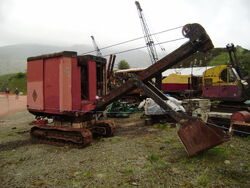
A Smith no.8 face shovel
Thomas Smith & Sons (Rodley) Ltd was formed in 1918, The firm originating in the Village of Rodley, Leeds in Yorkshire. The Firm were a builder of Steam Cranes for Railways and Quaries, before going on to build Diesel engined excavators and cranes, and eventually Lorry mounted Latice jib cranes.
History
| Please help improve this article or section by expanding it. Further information might be found on the talk page or at requests for expansion. |
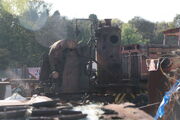
Remains of a rail mounted Smith steam crane in the National Coal Mining Museum for England storage yard
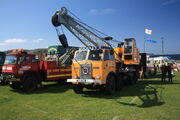
A Smith Rodley T10 ME crane on a Atkinson chassis at the Llandudno Transport Festival 2009
The Company started in 1820 when a firm of millwrights was started by Jeremiah Balmforth, David Smith, and Jeremiah Booth in the village of Rodley. The company progressed to making Stone cutting machinery & winches. By 1840 most of the equipment being made was cranes. These being of various capacities from 1/2 ton to 10 ton, hand operated machines. They built there first steam crane in 1860. By 1861 David Smiths Son Thomas had taken control. The company was run as a partnership with his sons till he died in 1902, with the sons incorporating the company in 1918, as Thomas Smith & sons (Rodley) Ltd.
Early Developments
- 1887 Built their first ever excavator, of a steam crane fited with a shovel attachment.
- 1894 Built their first ever Electric crane.
- 1887-1893 Contract to supply 5 & 10 ton Steamcranes to Manchester ship canal builders called "Thomas A Walker"
- 1900 Build a trencher machine designed by Jubb from Manchester. Built on a 3 Ton Steam crane.
- 1978 taken over by the NEI group who owned a number of related engineering and construction machinery businesses, before the 1980s recession forced the closure or disposal of a number of them.
The company built a several truck mounted cranes based on Cranecarriers from Atkinson, AWD.,Foden and Leyland.
Model Range
- Smith 1/3 yd. (1930)
- Smith 1/2 Yd.
- Smith 1/4 Yd. (1934)
- Smith Tree-Twelve. (1935)
- Smith Four-Fourteen. (1935)
- Smith Five-Twenty. (1935)
- Smith Two-ten (1935)
- Smith Seven
- Smith No.8 (eight)
- Smith No.10 (super-ten)(1946)
- Smith No.12 (19?
- Smith No.14 (1960)
- Smith No.21 (1946)
- Smith No.26 (1960)
- Smith no.28 (1970)
- Smith No.40 (1968)
- Smith E4000 Excavator
- Smith C4046 crane
- Smith C4050 crane
- Smith Eurocrane 25C
- Smith Eurocrane 35C
Preservation
A few examples of Smiths cranes and excavators are in preservation including;
- A Smith No. 8 (photo above) at the Vintage Excavator Trust museum in Cumbria.
- A Smith T10 ME of Buckley Crane Hire - VUG 175 on Atkinson chassis.(photo above)
- A Smith 14 crane parked at Andrew Beaulahs yard.
- Smith steam crane sn 9087/1917 ? as WD2528 at the Berlin Tecnical Museum
- Smith steam crane sn 9511/1920 ? 10T Capacity on 4+4 Wheel bogies Mexico City Museum
- Please add any other examples in preservation to this list
Template:PML Smith Rodley(link for future PML table)
Photo Gallery about THOMAS SMITH OF RODLEY Original Machinery Range
From the Wikipedia pages UPDATES
THOMAS SMITH & SONS LIMITED Early History
The history of the firm goes back to 1820 and a firm established by Thomas Smith's father David Smith in partnership with Jeremiah Balmforth and based in the nearby area of Calverley. Like several companies operating around Leeds at the time their business was supplying the machinery that would be used in the increasingly mechanised mills of the time. From 1840 hand operated cranes were added to their range of products and these would start a line of business that would be lucrative for all the partners and their descendants for many years. The company were joined by Jeremiah Booth in 1833, he left in 1847 and established his own 'Union Foundry' on Town Street, Rodley. That company also went on to produce large numbers of cranes and was passed on to Jeremiah Booth's son Joseph Booth in 1855, the name Joseph Booth & Bros was adopted.[1]
In the 1850s the original partnership was also passed on to the next generation. Jeremiah Balmforth died in 1858 and his son William Balmforth replaced him, the following year David Smith was succeeded by his son Thomas. Around 1860 they started to produce steam powered cranes capable of handling much larger loads. In 1861 there was a fall out between Balmforth and Smith, Thomas Smith bought out the company and took over its running. William Balmforth set up a new firm the 'Peel Ings Foundry' and remained in the crane manufacturing business. As well as steam cranes they also produced a small number of vertical boilered locomotives.[2] The Peel Ings Foundry didn't enjoy the same kind of success as the works of Thomas Smith and Joseph Booth though. It went bankrupt in 1916 and was bought by bridge maker Samuel Butler & Co but they closed down the works and began production of steam cranes for a time in their own works.
Thomas Smith brought his sons into his firm and they took over when he died in 1902. The company were incorporated as Thomas Smith & Sons in 1918.[3]
Products[edit]
One of the company's most popular products were fairly small steam powered cranes. Based on a tall central pivot and with the jib counterbalanced by the boiler these are commonly known as 'Leeds Type' cranes, they were either rail mounted where they were required to move around a site or ground mounted for the likes of quays. Joseph Booth also produced very similar cranes and with high demand at the time there were a few firms nearby that, though specialising in other products such as bridges and structural metal work, produced relatively small numbers of steam cranes. John Butler & Co, Samual Butler & Co (mentioned earlier), Isles and Whitaker Brothers are other local firms to have been involved in steam crane production.[4] The cranes were used in countless docks, railway yards, quarries and construction sites both at home and overseas. Some of the largest construction projects to use Smith cranes were the Manchester Ship Canal, the Aswan Low Dam, and the Sudan Barrage.[5] As early as 1897 Thomas Smith were producing electrical powered cranes and in later years the internal combustion engine would replace the steam engine as the power source in their cranes. The cranes were adapted to become excavators with buckets replacing the usual crane hook, the company also provided magnets for use in sites handling metals. Caterpillar track fitted versions were offered and these became more numerous in later years as the railway industry lost its dominance.[6]
Mergers[edit]
The company was taken over by Thomas Ward shortly before World War II, In 1978 they were taken over by Northern Engineering Industries. NEI had taken over many big manufacturing companies which already included Cowans Sheldon, Clyde Crane, Wellman Cranes and Smith's next door neighbours Joseph Booth. They all became part of the Crane and Bridge division of Clarke Chapman. This was taken over by Rolls Royce plc in 1989 and by Langley Holdings in 2001.
Today[edit]
The Clarke Chapman group still operate in Leeds but under the Wellman Booth name, though they are now situated in smaller premises at Yeadon[7] where the design and administration work is carried out, the engineering work taking place in Gateshead. Though Booth's works was demolished and redeveloped with housing, the former Thomas Smith works survives in other industrial use.
References[edit]
- Jump up^ Wellman Booth Company History
- Jump up^ Narrow Gauge News, August 2007
- Jump up^ The Yorkshire Group of 16mm Modellers
- Jump up^ Old Glory, Yorkshire Steam Crane Manufacturers, 3 part article: November 2011 - January 2012
- Jump up^ The Basic Industries of Great Britain, Lord Aberconway 1927
- Jump up^ Various company advertisements and brochures
- Jump up^ Wellman Booth's current website.
External links[edit]
- www.leedsengine.info page about Rodley crane makers
- Middleton Railway website page about Rodley crane makers
- Graces Guide entry about Thomas Smith.
- The Yorkshire Group of 16mm Modellers
- Wellman Booth's current website.
- Narrow Gauge News, August 2007
See also
References / sources
- Classic Plant & Machinery Magazine
- Cranes - An Illustrated History of, pub by Ian Allan
External links
- Interesting Dutch Fan site - note - In Dutch, (but some good pictures)




